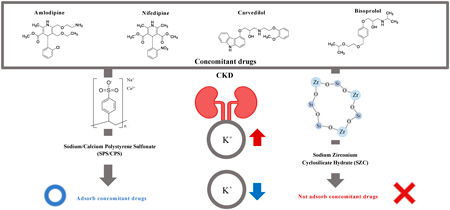Chemical & Pharmaceutical Bulletin ( IF 1.7 ) Pub Date : 2024-03-06 , DOI: 10.1248/cpb.c23-00687 Yuri Mizuno 1 , Fumihiko Ogata 1 , Yugo Uematsu 2 , Naohito Kawasaki 3
To explore drug interactions involving sodium zirconium cyclosilicate hydrate (SZC) and concomitant drugs like calcium antagonists (amlodipine and nifedipine) and β-blockers (carvedilol and bisoprolol), we investigate how these concomitant drugs influenced the administration of SZC in an artificial intestinal juice. Initially, we assessed the potassium ion adsorption capacity, ranking it as follows: calcium polystyrene sulfonate (CPS, 54.9 mg/g) < sodium polystyrene sulfonate (SPS, 62.1 mg/g) < SZC (90.8 mg/g). However, the adsorption equilibrium was achieved in the order of CPS ≒ SPS (within 1 min) < SZC (within 1 h). Subsequently, we determined the residual percentages of amlodipine, nifedipine, carvedilol, and bisoprolol, finding them to be 79.0–91.9% for SZC, 0.38–38.4% for SPS, and 0.57–29.0% for CPS. These results suggest the efficacy of SZC in managing hyperkalemia alongside concomitant drugs in an artificial intestinal juice, with particular emphasis on amlodipine (calcium antagonist) and carvedilol (β-blocker). Additionally, we identified the presence of carbon, nitrogen, and oxygen components from both drugs on the SZC surface following interaction. We also evaluated how amlodipine, nifedipine, carvedilol, and bisoprolol affected the administration of SZC in the presence of potassium ions. Our results indicate that potassium ions and concomitant drugs did not interfere with each other in the artificial intestinal juice. These results offer valuable insights into the administration of SZC in conjunction with concomitant drugs. Lastly, the presented data shows qualitative results in this study.
 Fullsize Image
Fullsize Image
中文翻译:

联合用药对人工肠液中环硅酸锆钠水合物的影响
为了探索环硅酸锆钠水合物 (SZC) 与钙拮抗剂(氨氯地平和硝苯地平)和 β 受体阻滞剂(卡维地洛和比索洛尔)等伴随药物的药物相互作用,我们研究了这些伴随药物如何影响人工肠液中 SZC 的给药。最初,我们评估了钾离子吸附能力,排序如下:聚苯乙烯磺酸钙(CPS,54.9 mg/g)<聚苯乙烯磺酸钠(SPS,62.1 mg/g)<SZC(90.8 mg/g)。然而,达到吸附平衡的顺序为CPS≒SPS(1分钟内)<SZC(1小时内)。随后,我们测定了氨氯地平、硝苯地平、卡维地洛和比索洛尔的残留百分比,发现 SZC 为 79.0-91.9%,SPS 为 0.38-38.4%,CPS 为 0.57-29.0%。这些结果表明,SZC 与人工肠液中的伴随药物一起治疗高钾血症具有功效,特别是氨氯地平(钙拮抗剂)和卡维地洛(β 受体阻滞剂)。此外,我们还确定了相互作用后 SZC 表面上两种药物中碳、氮和氧成分的存在。我们还评估了氨氯地平、硝苯地平、卡维地洛和比索洛尔在钾离子存在的情况下如何影响 SZC 的给药。我们的结果表明,钾离子和伴随药物在人工肠液中不会相互干扰。这些结果为 SZC 与伴随药物联合用药提供了宝贵的见解。最后,所提供的数据显示了本研究的定性结果。
 全尺寸图像
全尺寸图像



























 京公网安备 11010802027423号
京公网安备 11010802027423号